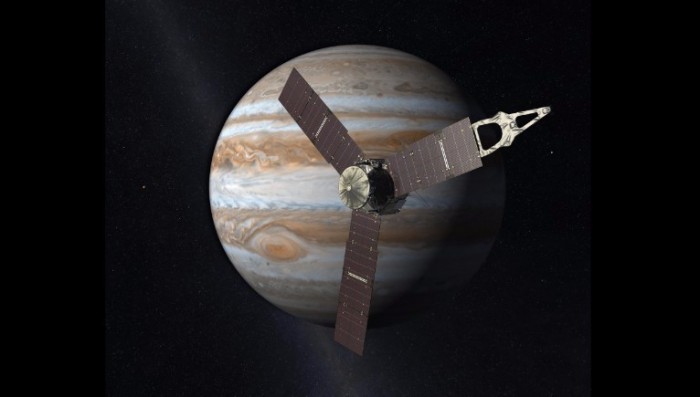Juno Mission: What It's About, How it Got its Name, Major Objectives & Astonishing Discoveries
Juno is a spacecraft launched in 2011 that entered into Jupiter’s orbit in 2016 to peer into the mystical clouds and unravel its stories of evolution and formation.

Scientists have been ever curious about the vast solar system; planets’ origins, formation of planetary systems, and especially the gas giant Jupiter have been a subject of deep interest and enigma. Juno Mission seeks to explore the yet-to-be-discovered intriguing facts about the solar system’s largest planet Jupiter.
The team at NASA has put several top-notch scientific instruments (magnetometer, ultraviolet imaging spectrograph, microwave radiometer, and many others) into place in order to achieve a certain set of objectives.
So let’s now know what the JUNO mission is all about, how it got its name, what are its objectives, and what astonishing discoveries have been made so far.
Why Was the Mission Named “Juno”?
The name “Juno” finds its origins in ancient Roman folklores. According to these myths, Juno was Jupiter’s wife. Jupiter would hide behind the clouds so that nobody could see him creating trouble but it was Juno could see through the clouds.
And so the Juno spacecraft can see deep beneath the clouds of planet Jupiter. It is helping scientists in gaining a better understanding of Jupiter and other planets’ evolution.
What is Juno Mission All About?

The NASA spacecraft Juno was launched from Earth on 5 August 2011. After making deep space maneuvers in August-September 2012 and flyby of Earth in October 2013, it ultimately arrived at Jupiter’s orbit on July 4, 2016.
Juno is the spacecraft that, for the first time, got this close to the dense cover of clouds so as to dig answers about this gas giant and our solar system’s origins. Juno's major goal is to unravel the story of Jupiter's evolution and formation with the help of long-proven technologies.
The mission is anticipated to deorbit into Jupiter through July 2018 for a total of 12 science orbits. (14.1)
What are Juno Mission’s Key Objectives?

The Juno spacecraft has made use of a suite of science instruments to achieve the following set of scientific objectives:
- Obtaining a better estimate of Jupiter’s core mass. This will help in identifying existing theories that associate Jupiter's formation to the solar system.
- Mapping Jupiter’s magnetic field in a precise manner for determining the origin, structure, and depth of field. It will also help in understanding the fundamental physics of dynamo theory.
- Characterizing and exploring the 3D structure of the polar magnetosphere and auroras of Jupiter.
- Mapping the gravitational field of Jupiter for assessing the mass distribution in its interior, including properties of its structure and dynamics.
- Finding out the oxygen to hydrogen ratio for effective measurement of water on Jupiter. It will help in identifying among existing theories that link the formation of Jupiter to the solar system.
- Measuring the orbital frame-dragging (Lense-Thirring precession) that is caused due to Jupiter’s angular momentum. It is plausibly a new test of general relativity effects linked with the Jovian rotation.
- Mapping the change in temperature, structure, cloud opacity, atmospheric composition, and dynamics for pressures much higher than 100 bars at all latitudes.
Amazing Discoveries Made So Far

After looking at the first results, the scientists are startled as Jupiter doesn’t look anything from the poles like it does from the usual view or what was expected. It appeared uniform from the inside but it’s, in fact, very complex.
And interestingly enough, Jupiter is plausibly the first planet to have formed in the solar system. It consists of some of the ingredients of the collapsing nebula that led to the formation of the solar system. (14.2)

They even spotted and snapped the Great Red Spot that has been swirling for centuries. It’s about 10,000 miles wide and used to be even bigger earlier. Also, Jupiter’s auroras are a powerful mystery having humongous electric potentials around 10 and 30 times greater than any seen on Earth!
Popular Posts
What Is Trypophobia – A Disgust More Than Fear
"I can't really face small, irregularly or asymmetrically placed holes, they make me like, throw up in my mouth, cry a little bi...
Chandan Roy
16 Interesting Facts About Ambidextrous People
A lefty or left-handed uses his left hand more naturally and dominantly than the right hand. And the righty or right-handed is o...
Ethan Stephans
20 Interesting Facts About Meteoroid, Meteor and Meteorite
Watching celestial objects is a true delight. It is still fun to catch a sight of shooting stars when we grow up. A second of th...
Swati Bhandari








